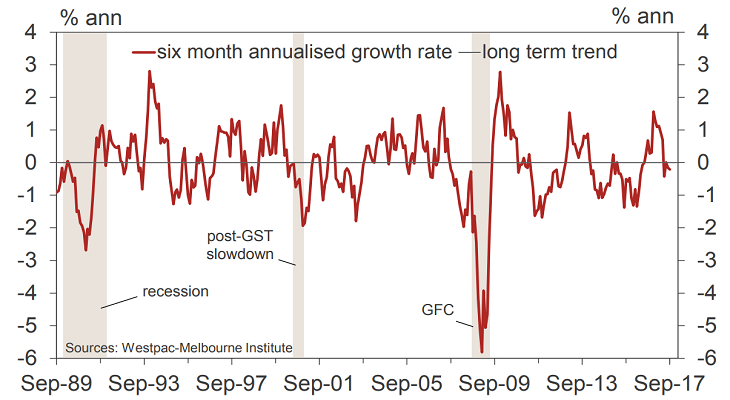Westpac and the Melbourne Institute describe their Leading Index as a composite measure which attempts to estimate the likely pace of economic activity relative to trend in Australia. The index combines certain economic variables which are thought to lead changes in economic growth into a single measure which is claimed to be a reliable cyclical indicator for the Australian economy and a “critical” indicator of swings in Australia’s overall economic activity.
For the last four months, the Leading Index has returned values which imply below-trend growth. September’s reading returned a value of -0.21%, a modest decline from August’s revised reading of -0.16% (revised up from -0.19%).

According to Westpac chief economist Bill Evans, a deterioration in conditions since April has been driven in the main by two factors. Commodity prices have fallen, which means Australian exporters are likely to earn less income as shipments and payments are made on contracts in the period.
The other driving force has been the fall in the S&P/ASX200 index from 5924 at the end of April to 5681 at the end of September. Share prices are thought to have leading indicator properties, although “they are much more volatile than the real economy and might provide false signals about economic growth.”*
Evans thinks the RBA is currently primed to raise rates next year based on its forecast for Australian economic growth in 2018. However, he thinks the RBA Board will change its mind as information becomes available. “We assess that the Bank, with a much more optimistic outlook for the economy than Westpac, expects to be increasing rates. However the developments in the economy which we anticipate are likely to lead the Bank to revise its view and keep rates on hold.”
Bond yields fell on the day but generally reactions from various markets was unremarkable. The 3 year bond yield slipped 2bp to 2.10% and the 10 year yield lost 4bps to 2.75%. The Australian dollar was essentially unchanged against the U.S. dollar and the euro.
*Stock Prices and Economic Growth, European Central Bank, October 2012

